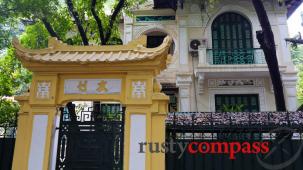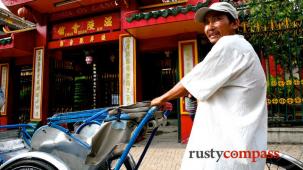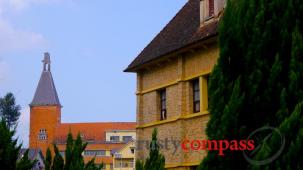Ba Dinh Square is Hanoi's political and historic heart. It was here in 1945 that Ho Chi Minh declared Vietnamese independence after decades of conflict - first with French and then with Japanese occupation forces. His independence declaration drew heavily from the United States' version and was heard approvingly by US intelligence officers who had collaborated with his men in fighting the Japanese in WWII. Soon after, the French commenced moves to reclaim their erstwhile colony. Ho Chi Minh and his followers were forced back to the jungle. It was three decades and millions of lives later in 1975 before his ambition of a united Vietnam was realised.
Ho was six years dead when South Vietnamese forces capitulated and the last US forces exited Saigon on April 30 1975. The centrepiece of Ba Dinh square is Ho Chi Minh's Mausoleum. While Ho had expressed a desire to be cremated, the clique that succeeded him had other ideas. In Soviet style, they built a massive monument that seems incongruous both with the popular image of the man and his simple home nearby.
Ho Chi Minh's Mausoleum - inaugurated in 1975, the year that Ho's dream of Vietnamese unification was achieved.
Ho Chi Minh's house on stilts is a short walk from his mausoleum. The ascetic Ho refused to live in the ostentatious French Governor's residence a few hundred metres away. Instead he commissioned this simple timber home inspired by the stilted houses of Vietnam's montagnard people.
Ho Chi Minh's house on stilts.
Ho Chi Minh's open air answer to the White House Situation Room?
This small lake outside Ho's house is filled with carp. Tour guides will tell you that Ho taught the carp to come when he clapped - as they do today.
Ho Chi Minh's Museum was a final dedication to Vietnam from the Soviet Union before its collapse in 1989. Remarkably, as with Ho's mausoleum, its designers claim to have been inspired by the lotus flower. There are Ho Chi Minh Museums throughout Vietnam - if you only visit one, make it this one.
The collection is eye catching, imaginative and at times quite bizarre. Unfortunately, the English language translation is limited.
The One Pillar Pagoda, the oldest monument in Ba Dinh Square was rebuilt in the 1950s after vanquished French soldiers destroyed its predecessor in a rampage of vandalism as their colonial rule crumbled. Emperor Ly Thai Tong built the lotus inspired structure on a single pillar in 1049 to express his gratitude to Quan Am, the Goddess of Mercy following the birth of his son.
Buddhist nuns at the One Pillar Pagoda.
The former French Governor's residence - now the Presidential Palace in Ba Dinh Square Hanoi.
The early twentieth century saw a campaign of massive public works in Hanoi by the French colonial administration. Most of the major colonial era structures in the square as well as the Long Bien Bridge were built during this period. The building was funded by heavy taxes and exploitation of the local population rather than the rich bounty of empire.
Ba Dinh Square was marked out to be the centre of a grand colonial administration for the whole of Indochina. Land was confiscated from residents and a pagoda dating back to the founding of Hanoi 1000 years ago was destroyed.
Ernest Hebrard was one of the most celebrated architects of the French colony. This 1920s building, now the Ministry of Foreign Affairs looks over Ba Dinh Square. His other celebrated work is now the Museum of Vietnamese History in the French Quarter of the city.



























